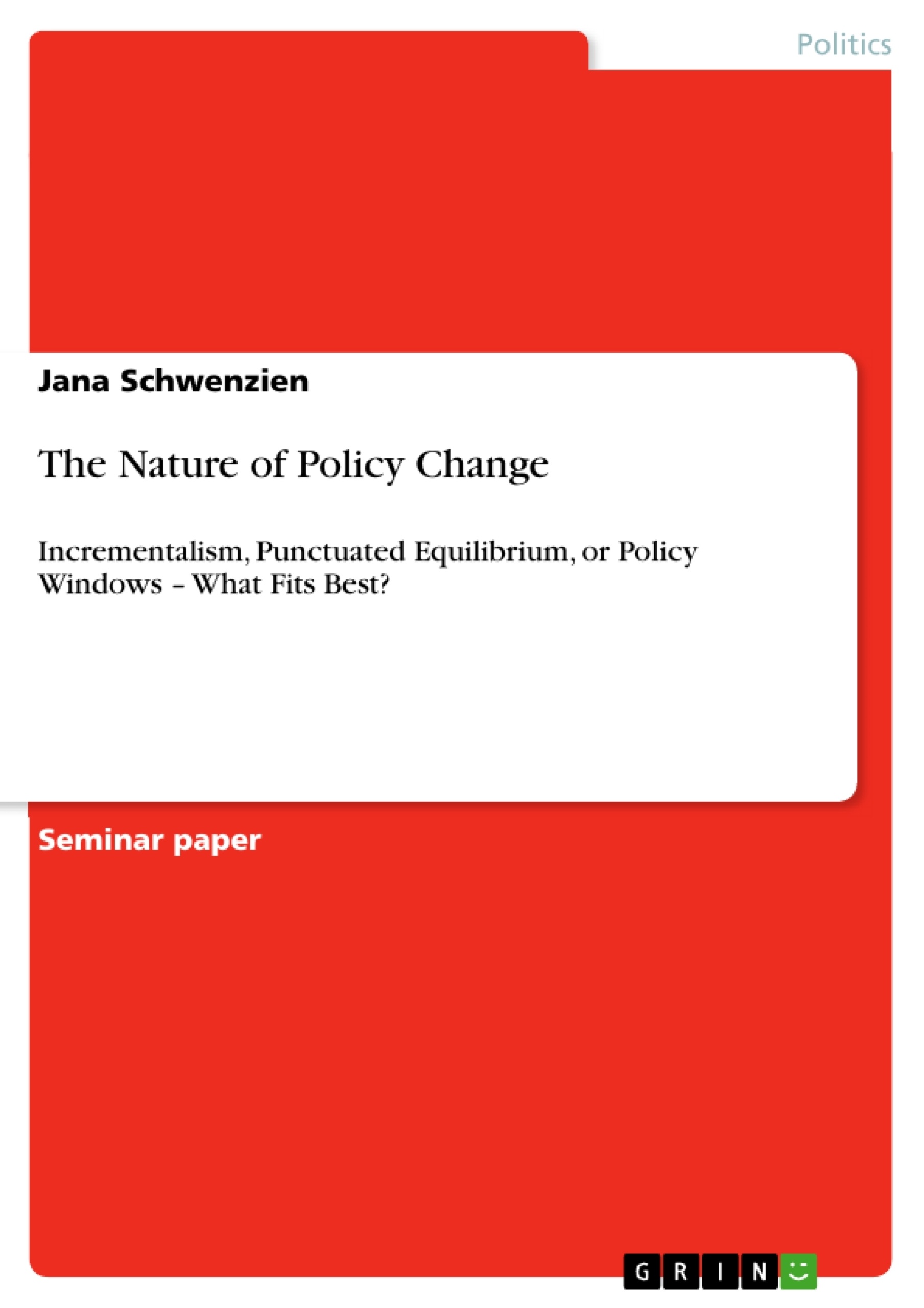Politics and media announce that we need a major policy change regarding the forthcoming problems and challenges related to climate change. But what is policy change? Policy change in this paper is understood as a major change or reversal in attitude or principle or point of view. But when and how does such changes happen? This work aims to look at policy change from a theoretical point of view by contrasting three different theoretical approaches regarding their explanatory power for policy change. The paper deals with Lindblom’s incrementalism (1959; 1979), Kingdon’s policy windows (1995), as well as Baumgartner and Jones’s theory of punctuated equilibrium (1991). The theories and concepts of agenda setting and policy change are closely related in the literature on policy making. Since Lindblom’s "The Science of Muddling Through" (1959), patterns of policy change were analyzed regarding different elements such as policy entrepreneurship (Kingdon 1984; 1995) or issue expansion and venue shopping (Baumgartner and Jones 1991). Roughly spoken there are two competing views on changes in policy making in the literature: the stability in policy making and the incremental nature of policy change as introduced by Lindblom (1959), and episodes of abrupt changes elaborated by Baumgartner and Jones in their punctuated equilibrium theory (1991; 1993). Most studies of agenda setting focus only on a narrow set of theoretical principles, thus producing incomplete and sometimes conflicting explanations for policy change. The theoretical frameworks by Lindblom, Kingdon, and Baumgartner and Jones take different views concerning the type of policy change. The aim of this essay is to take a closer look in order to determine whether these three approaches are competing or rather complementary in identifying the causal mechanisms driving policy change. Therefore questions such as the following are discussed: What level of analysis do the three approaches focus on? What predictions do they offer? What factors do they exclude?
Inhaltsverzeichnis (Table of Contents)
- Introduction
- Three Different Views on Policy Change
- Lindblom's Incrementalism
- Type of policy change and explanation when it happens
- Predictions and level of analysis
- The role of specific actors and excluded factors
- Kingdon's Policy Windows
- Type of policy change and explanation when it happens
- Predictions and level of analysis
- The role of specific actors and excluded factors
- Baumgartner and Jones's Punctuated Equilibrium
- Type of policy change and explanation when it happens
- Predictions and level of analysis
- The role of specific actors and excluded factors
- Lindblom's Incrementalism
- The Nature of Policy Change – Which Theory Fits Best?
Zielsetzung und Themenschwerpunkte (Objectives and Key Themes)
This paper explores the nature of policy change by analyzing three distinct theoretical frameworks: Lindblom's incrementalism, Kingdon's policy windows, and Baumgartner and Jones's punctuated equilibrium. It aims to assess the explanatory power of these approaches in understanding policy change and determine whether they complement or compete with each other. The paper specifically examines the level of analysis, predictions, and factors included and excluded by each theory.
- The nature of policy change: incremental vs. abrupt
- The role of specific actors and their influence on policy change
- The level of analysis used by each theoretical approach
- Predictions and implications of each theory for policy change
- Strengths and weaknesses of each theory in explaining policy change
Zusammenfassung der Kapitel (Chapter Summaries)
- Introduction: This chapter defines policy change as a significant shift in attitudes, principles, or viewpoints and introduces the three theoretical approaches analyzed in the paper: Lindblom's incrementalism, Kingdon's policy windows, and Baumgartner and Jones's punctuated equilibrium. It highlights the close relationship between agenda setting and policy change in the literature and outlines the structure of the paper.
- Three Different Views on Policy Change: This chapter provides a detailed analysis of each theoretical approach, examining the types of policy change they describe, their predictions, level of analysis, and the role of specific actors.
- Lindblom's Incrementalism: This section discusses incrementalism as an evolutionary process of gradual change in policy through small steps, highlighting Lindblom's argument that drastic policy change is unlikely due to the constraints of market-oriented democracies and the need to maintain a fundamental consensus on governing rules and values. It examines the structural factors, such as the market and veto powers, that contribute to incremental policy change.
Schlüsselwörter (Keywords)
The key concepts explored in this paper include incrementalism, punctuated equilibrium, policy windows, agenda setting, policy change, market-oriented democracies, structural factors, veto powers, and policy entrepreneurship. The focus is on analyzing and contrasting different theoretical approaches to understanding the nature of policy change and their implications for policy making.
- Quote paper
- Jana Schwenzien (Author), 2009, The Nature of Policy Change, Munich, GRIN Verlag, https://www.hausarbeiten.de/document/155162


